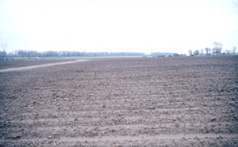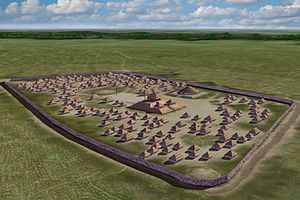Nodena site
Nodena site | |
 Fields at the Nodena site | |
| Nearest city | Wilson, Arkansas |
|---|---|
| Coordinates | 35°36′9″N 89°58′45″W / 35.60250°N 89.97917°W |
| Area | 305 acres (123 ha) |
| NRHP reference No. | 66000201[1] |
| Significant dates | |
| Added to NRHP | October 15, 1966[1] |
| Designated NHL | February 19, 1964[2] |
The Nodena site is an
In 1900, a
In 1964, the Nodena site was declared a National Historic Landmark[2] and in 1966 it was added to the National Register of Historic Places.[1]Culture of the Nodena people
Nodena is the type site for an important Late Mississippian cultural component, the Nodena phase, which dates from about 1400–1700 CE. The Nodena phase was a collection of villages (see Eaker site) along the Mississippi River between the Missouri Bootheel and Wapanocca Lake. This culture is contemporary with the Menard complex, Tipton phase, Walls phase and the Parkin phase. The Parkin Indian Mound, the type site for the Parkin phase, is the site of another Late Mississippian village located in Parkin, Arkansas, about 30 miles (50 km) southwest of Wilson. In the early 1540s, the Spanish Hernando de Soto Expedition is believed to have visited several sites in the Nodena phase, which is usually identified as the Province of Pacaha.[6] The Parkin site is a candidate for the province of Casqui.[7][8] Nodena people were part of the Southeastern Ceremonial Complex, an extensive religious and trade network that brought chert, whelk shells, and other exotic goods to the site.
Nodena village 1400–1650 CE

The site was a 15 acres (6 ha) palisaded village on a horseshoe bend of the Mississippi River about 5 miles (8 km) east of Wilson, Arkansas. Archaeological artifacts from the villages of the Nodena people are dated to 1400–1650 CE.
The site had three to eight mounds, two of them large
The houses in the village were laid out in a very orderly fashion, located on the same axis as the mounds at the site, demonstrating that the whole site was planned.
The de Soto chroniclers indicate that political provinces characterized by a paramount chief living in a paramount town with satellite vassal towns surrounding it were the major political institutions of this area. The Nodena site was either the main town or one of the larger satellite towns of the Pacaha province.
 |
 |
Pottery
Most pottery found at the Nodena site is of the kind known as Mississippian Bell Plain. It was buff colored, contains large fragments of ground
Head deformation

The people of the Nodena phase practiced
Agriculture and food
The people of Nodena were intensely involved in
Language
The peoples of Nodena were probably
Dr. James K. Hampson
The museum for the Nodena site is named after
ThePrehistoric Mastodon skeleton
See also
- Eaker site
- Mississippian culture
- Southeastern Ceremonial Complex
- List of Mississippian sites
- List of sites and peoples visited by the Hernando de Soto Expedition
- List of burial mounds in the United States
References
- ^ a b c "National Register Information System". National Register of Historic Places. National Park Service. July 9, 2010.
- ^ a b "Nodena site". National Historic Landmark summary listing. National Park Service. Archived from the original on March 1, 2007. Retrieved February 21, 2009.
- ^ a b "The Virtual Hampson Museum". Center for Advanced Spatial Technologies. University of Arkansas, Fayetteville, Arkansas. Retrieved February 21, 2009.
- ^ a b c "Hampson Archeological Museum State Park". Archeological Collection of Nodena Artifacts. Arkansas Department of Parks and Tourism, Division of State Parks. Retrieved February 21, 2009.
- ^ a b
Williams, Steven (April 1957). "The Island 35 Mastodon: Its Bearing on the Age of Archaic Cultures in the East". American Antiquity. 22 (4): 359–372. JSTOR 276134.
- ^ ISBN 1-56349-057-9.
- ^ a b c
Hudson, Charles M. (1997). Knights of Spain, Warriors of the Sun. University of Georgia Press.
- ^
OCLC 7540091. Unknown ID 0882-4591.
- ISBN 0-8173-0455-X.
- ^ Williams, Steven (April 1957). "James Kelly Hampson. 1877-1956". American Antiquity. 22 (4): 398–400. .
- ^ "Greek mastodon find 'spectacular'". BBC News. July 24, 2007. Retrieved October 7, 2007.


